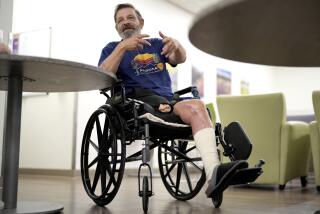Hot advice from experts on handling a sunburn
- Share via
You know you shouldn’t have, but you did. You got sunburned. And now you’re itching to know what to do about it.
Here are a few tips from Dr. Latanya Benjamin, a pediatric dermatologist at Lucile Packard Children’s Hospital at Stanford University and an assistant clinical professor of dermatology and pediatrics at Stanford School of Medicine; Dr. Ray Jalian, a clinical instructor in dermatology at UCLA; and Dr. Stefani Takahashi, an associate professor of dermatology at USC.
Use your head: At the first sign that you’re burning — your skin is turning pink or feeling tender or well, like it’s burning — get out of the sun. “This seems obvious,” Takahashi says, “but you’d be surprised.”
Cool down: Take a cool bath or shower, avoiding harsh soaps and making sure to pat — not rub — yourself dry. Applying cold compresses is also a good idea. The point is to take the heat out of your skin and reduce any possible swelling. Variations on these basics include adding oatmeal or milk to your bath water or making a compress with vinegar or green tea. But there is no scientific evidence that these extras give better results.
Rehydrate yourself, inside and out: When you get sunburned, you can also get dehydrated, so it’s important to replenish your fluid supplies. One way is to drink plenty of water, perhaps fortified with electrolytes. But you should also moisturize your poor skin directly. First a warning: Petroleum jelly is not a good option. It holds heat in. Fortunately, you still have a few million products (give or take) to choose from. Unfortunately, there’s little evidence as to which ones work best.
Aloe vera and topical steroid creams have their fans, but a 2005 study in the Journal of the Medical Assn. of Thailand found that 70% aloe vera cream was no better than a placebo. Also, a 2008 study published in the Archives of Dermatology found that topical steroids of moderate or high potency did not provide clinically useful sunburn reduction when applied either six or 23 hours after being in the sun. The study does not foreclose the possibility that topical steroids may be useful if applied sooner, and both Benjamin and Takahashi say they may work as mild anti-inflammatories. But Jalian cautions against using them except under a doctor’s instructions. As a general rule, he warns, you should be careful about what you try: “When your skin is burned, it’s more absorbent than usual. You could absorb too much of something.”
All of the above is true for children too — and then some. They can burn faster than the rest of us and dehydrate faster too. “I tend to treat skin very carefully,” pediatric specialist Benjamin says, “minimizing fancy products, minimizing topicals, focusing on hydration and healthy foods.” She suggests that rehydration in kids should include foods rich in antioxidants, which have healing properties, such as watermelon, tomatoes and cucumbers.
Ease the pain: If you’re hurting, take an anti-inflammatory. Ibuprofen can help decrease the redness as well as reduce the pain. Acetaminophen can help the pain, but not the redness.
Follow a hands-off policy with blisters. No matter how uncomfortable they are, leave your blisters alone. Don’t scratch them or pop them or do anything else you’re tempted to do to them. And even after they’ve drained, don’t peel off the overlying skin,. “It serves as a biological band-aid,” Jalian says. (If the itching is driving you up the wall, Benadryl may help.)
Consider seeing a doctor: If your pain or blistering is severe, especially if you have systemic symptoms (such as a headache, fever and/or chills), you should see your primary care physician or a dermatologist. And remember, when babies get burned, they’re at a big disadvantage. “They can’t tell you if they have a headache or chills or a fever,” Benjamin says, so parents should be on guard for telltale signs.
Stay out of the sun as much as possible: Not to be cruel, but, of course, that would have been a good idea before you got burned. No matter. Be sure to do it now — and from now on. Don’t let this happen again.
Sunburn still common despite warnings
Stuff happens — sunscreen gets lost, hats get blown away, people get stranded on desert islands — and then sunburns can happen too. In fact, they happen at least once a year to more than 40% of adults in this country, according to a 2007 survey by the Skin Cancer Foundation and iVillage.
The odds are worse for young adults. In the National Health Interview Survey in 2010, about half of those ages 18 to 29 — and nearly two-thirds of caucasians — reported having at least one sunburn during the last year.
And despite decades of warnings that the sun isn’t always your friend, that besides making you as wrinkly as a Shar Pei, it can give you cancer, the trend is in the wrong direction. While sunburn rates had fallen about 5% from 2000 to 2005, the 2010 figures had lurched back up to 2000 levels.
ALSO:
Got a fun, creative way to get fit? Join #LATFit
Gear: Running shoes put an extra spring in your step
Fitness instructor Tracy Anderson says the exercise habit requires focus






